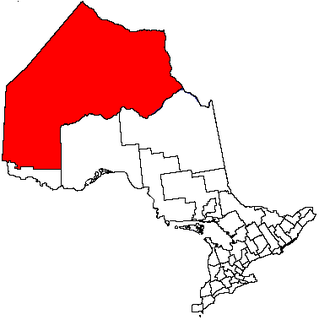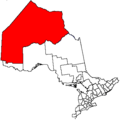Grievances
The First Nation has recently settled two grievances against Hydro One and Ontario Power Generation. The grievance against Hydro One was started because the company arbitrarily cut down trees, and misappropriated land without making any effort to consult the First Nation to install huge steel electricity pylons across the reserve. Hydro One acknowledged liability (without an apology) by settling the claim for an undisclosed amount.
The grievance against Ontario Power Generation was a far bigger issue. Many years ago, again without notice or an effort to consult with the First Nation, what used to be called Ontario Hydro arbitrarily flooded over one thousand acres (4 km²) of reserve land and many more thousands of acres of traditional resource area by building the Whitedog Dam to provide electricity for sale by Ontario Hydro.
The detrimental effects of the flooding and water flow change resulted in a huge loss of culture for the area's First Nation people, including but not limited to the loss of cultural activities such as hunting, and rice harvesting.
Ontario Power Generation acknowledged liability by settling for an undisclosed amount. Also, unlike Hydro One, Ontario Power Generation officially apologized for the harm to the community during a visit to the community by Jake Epp, Chairman of the Board.
Legal grievances remain as a result of Canada's Federal Government giving Ontario Power Generation permission to reroute the Winnipeg River through the reserve via the relief channel blasted through the reserve.
A rock sacred to the people of Ochiichagwe'Babigo'Ining was also completely destroyed by explosives to clear way for the water channel.

Lake of the Woods is a lake occupying parts of the Canadian provinces of Ontario and Manitoba and the U.S. state of Minnesota. It separates a small land area of Minnesota from the rest of the United States. The Northwest Angle and the town of Angle Township can be reached from the rest of Minnesota only by crossing the lake or by traveling through Canada. The Northwest Angle is the northernmost part of the contiguous United States. Its "northwesternmost point" served as a problematic landmark in treaties defining the international border.
First Nations in Ontario constitute many nations. Common First Nations ethnicities in the province include the Anishinaabe, Haudenosaunee, and the Cree. In southern portions of this province, there are reserves of the Mohawk, Cayuga, Onondaga, Oneida, Seneca and Tuscarora.

Eabametoong, also known as Fort Hope or Eabamet Lake by Canada Post, is an Ojibway First Nations band government in Kenora District, Ontario, Canada. Located on the shore of Eabamet Lake in the Albany River system, the community is located approximately 300 kilometres northeast of Thunder Bay and is accessible only by airplane via Fort Hope Airport or water, or by winter/ice roads, which connect the community to the Northern Ontario Resource Trail. The Eabametoong First Nation Reserve is completely surrounded by territory of the Unorganized Kenora District.

The Treaty Three Police Service (T3PS) in Ontario began as the Treaty #3 Policing Initiative in August 1999 as directed by the Executive Council of Grand Council of Treaty 3. It officially began operation on August 5, 2003, and became Canada's newest First Nation self-administered police service. Members of Treaty Three Police are appointed as First Nations Constables by the Commissioner of the OPP pursuant to s.54 of the Police Services Act. They have the powers of a police officer for the purpose of carrying out duties specified in their appointments and under federal law have the powers and protections of peace officers. Because First Nations Constables are not police officers as defined by the Police Services Act, their status in law is different but equal to that of a police officer. The jurisdiction of the Treaty Three Police Service includes all signatory Treaty Three First Nations previously policed by the OPP administered First Nations Policing Program. The OPP are mandated to provide policing on a reserve, village or any other area not currently under a policing agreement. All operations save major crimes are investigated by Treaty Three First Nations Constable patrol officers and/or the T3PS Crime Unit. The Service exists with the unanimous agreement of the signatory Band Councils or Band Chiefs. Unlike police forces in cities and towns, the Treaty Three Police Service is not required to provide all the regular services of a police force but does provide virtually everything needed.

Deer Lake First Nation is an Oji-Cree First Nation band government in Northern Ontario, located north of Red Lake, Ontario, Canada. It is one of the few First Nations in Ontario to have signed Treaty 5. It is part of the Keewaytinook Okimakanak Council and the Nishnawbe Aski Nation. As of December, 2007, the First Nation had 1,072 registered members, of which their on-reserve population was 868.
Ojibways of Onigaming or Onigaming First Nation is an Anishinaabe community in Northwestern Ontario, Canada. The present day reserve is on a portage between Lake of the Woods and Crow Lake, intersected by Highway 71. The traditional name for this settlement is Kakagewaatisoonigaming, or Raven's Nest Portage. This community was formerly known as "Sabaskong", a corruption of the Ojibway name "Shebiiskaang" which refers to the "old reserve" located near Turtle Narrows on Lake of the Woods. This community is still known colloquially as "Sab".

Lac Seul First Nation is an Ojibwe First Nation band government located on the southeastern shores of Lac Seul, 56 kilometres (35 mi) northeast of the city of Dryden, Ontario. Though Lac Seul First Nation is a treaty signatory to Treaty 3, the First Nation is a member of the Independent First Nations Alliance, a regional tribal council and a member of the Nishnawbe Aski Nation.

Wabigoon Lake Ojibway Nation, or commonly as Wabigoon First Nation, is a Saulteaux First Nation band government who inhabit the Kenora District in northwestern Ontario, Canada. It is approximately 19 km southeast of Dryden, Ontario. As of January 2008, the First Nation had a registered population of 533 people, of which their on-Reserve population was 175.
Wabaseemoong Independent Nations or more fully as the Wabaseemoong Independent Nations of One Man Lake, Swan Lake and Whitedog, is an Ojibway First Nation band government who reside 120 km northwest of Kenora, Ontario and 13 kilometres (8.1 mi) east of the Ontario-Manitoba border of northwestern Ontario, Canada. As of December, 2018, the First Nation had a population of 2,000 registered people, of which their on-Reserve population was 1200 registered members and approximately 100 non-Band members.

Ginoogaming First Nation is a small Anishinaabe (Ojibway) First Nation reserve located in Northern Ontario, located approximately 40 km east of Geraldton, Ontario, Canada, on the northern shore of Long Lake, immediately south of Long Lake 58 First Nation and the community of Longlac, Ontario. As of September, 2006, their total registered population was 773 people, of which their on-Reserve population was 168.

The Dalles 38C is an Ojibway First Nation reserve in Kenora District, and is the main reserve of the Ochiichagwe'Babigo'Ining Ojibway Nation.

Ojibways of the Pic River First Nation is an Ojibway (Anishinaabe) First Nation reserve on the northern shore of Lake Superior at the mouth of the Pic River. Pic River is not a signatory to the Robinson Superior treaty; however, they did petition, starting in 1879, for a reserve and the request was subsequently granted. The community is located on the 316.6-hectare (782-acre) Pic River 50 Indian reserve. In November 2007, their total registered population was 964 people, of which their on-reserve population was 480.
Big Grassy First Nation is an Ojibwe or Ontario Saulteaux First Nation band government located in Rainy River District, Ontario near Morson, Ontario. Together with the Ojibways of Onigaming First Nation, Big Grassy First Nation is a successor apparent to the former Assabaska Band of Saulteaux. Total registered population in February, 2012, was 721, of which the on-reserve population was 228. The First Nation is a member of the Anishinabeg of Kabapikotawangag Resource Council, a regional tribal council that is a member of the Grand Council of Treaty 3.
Ojibways of Onigaming First Nation is an Ojibwe or Ontario Saulteaux First Nation located in Kenora District, Ontario near Nestor Falls, Ontario. Together with the Big Grassy First Nation, Ojibways of Onigaming First Nation is a successor apparent to the former Assabaska Band of Saulteaux. Total registered population in February, 2012, was 737, of which the on-reserve population was 445. The First Nation is a member of the Anishinabeg of Kabapikotawangag Resource Council, a regional tribal council that is a member of the Grand Council of Treaty 3.

Anishinabe of Wauzhushk Onigum is an Anishinaabe First Nation in northwestern Ontario. Its reserves include Kenora 38B and the shared reserve of Agency 30. It is a part of the Anishinabeg of Kabapikotawangag Resource Council, a party to the Grand Council of Treaty 3. Wauzhushk Onigum is govern by 1 Chief and 3 Council members. Current Chief is Chris Skead and council members are Dave Skead, Ed Skeid and Donald Biggeorge. Chief and council are elected by members of Wauzhushk Onigum.
Bimose Tribal Council is a First Nations council, one of three such councils on the Grand Council of Treaty 3. Its members include:

Agency 30 is a First Nations reserve on the Aulneau Peninsula of Lake of the Woods in northwestern Ontario. It is shared by 13 First Nations:

Sabaskong Bay 35F is a First Nations reserve on Lake of the Woods, straddling the border of Kenora District and Rainy River District in Ontario. It is one of the reserves of the Ojibways of Onigaming First Nation.






